-
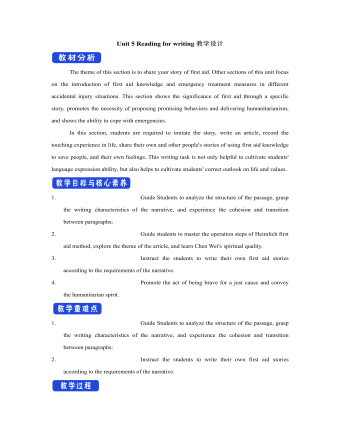
新人教版高中英语选修2Unit 5 Reading for writing教学设计
你校英语报计划出版一期急救常识专刊,现面向全校学生公开征集稿件,你有意参加。请你根据下面提示内容,用英语写一篇短文,介绍在车祸现场对伤者进行急救的方法和步骤。1.确保现场的安全;2.询问伤者,确保其呼吸正常;3.检查伤口,如流血则应采取止血措施;4.如需急救,确保其处于康复位置。注意:1.词数80左右;2.可以适当增加细节,以使行文连贯。参考词汇:康复位置 recovery positionAs we all know, having a knowledge of first aid can make a great difference in our daily life. If a traffic accident happens and someone is injured, the following steps can be used to treat the injured.In the first place, we should make sure that the accident scene is safe so that we won’t get hurt. We should ask the injured person if he is OK, and see if he is breathing. What’s more, we should check for cuts and wounds. If he is bleeding badly, it is vital that we should try to stop the bleeding by applying pressure to the injury. This is because if a person loses too much blood, he may die. If necessary, take the injured person to the hospital as soon as possible.Do remember: when giving first aid, please be sure to place the person in a recovery position.
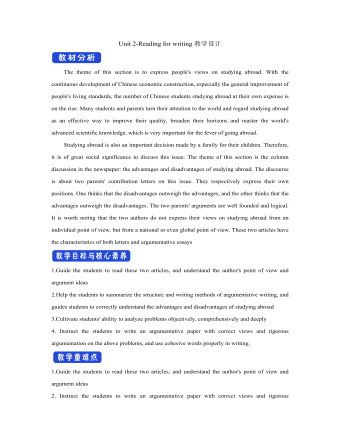
新人教版高中英语选修2Unit 2 Reading for writing教学设计
The theme of this section is to express people's views on studying abroad. With the continuous development of Chinese economic construction, especially the general improvement of people's living standards, the number of Chinese students studying abroad at their own expense is on the rise. Many students and parents turn their attention to the world and regard studying abroad as an effective way to improve their quality, broaden their horizons and master the world's advanced scientific knowledge, which is very important for the fever of going abroad. Studying abroad is also an important decision made by a family for their children. Therefore, it is of great social significance to discuss this issue. The theme of this section is the column discussion in the newspaper: the advantages and disadvantages of studying abroad. The discourse is about two parents' contribution letters on this issue. They respectively express their own positions. One thinks that the disadvantages outweigh the advantages, and the other thinks that the advantages outweigh the disadvantages. The two parents' arguments are well founded and logical. It is worth noting that the two authors do not express their views on studying abroad from an individual point of view, but from a national or even global point of view. These two articles have the characteristics of both letters and argumentative essays1.Guide the students to read these two articles, and understand the author's point of view and argument ideas2.Help the students to summarize the structure and writing methods of argumentative writing, and guides students to correctly understand the advantages and disadvantages of studying abroad3.Cultivate students' ability to analyze problems objectively, comprehensively and deeply
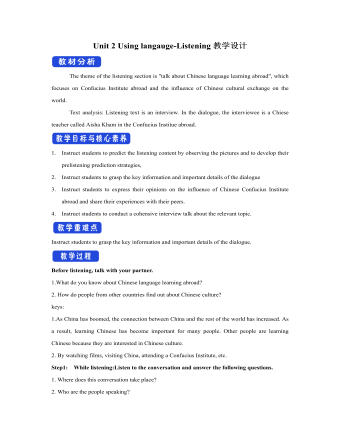
新人教版高中英语选修2Unit 2 Using langauge-Listening教学设计
? B: Absolutely! Getting involved with Chinese cultural activities there definitely helped a lot. I got to practice my Chinese on a daily basis, and I could learn how native Chinese speakers spoke.? A: What do you feel is your biggest achievement?? B: Learning Chinese characters! I have learnt about 1,500 so far. When I first started, I didn't think it was even going to be possible to learn so many, but now I find that I can read signs, menus, and even some easy newspaper articles.? A: What are you most keen on?? B: I've really become keen on learning more about the Chinese culture, in particular Chinese calligraphy. As I have learnt Chinese characters, I have developed a great appreciation for their meaning. I want to explore Chinese characters by learning how to write them in a more beautiful way. ? A: Finally, what do you want to say to anyone interested in learning Chinese?? I have really become keen on learning more about the Chinese culture, in particular Chinese Calligraphy. As I have learnt Chinese character, I have developed a great appreciation for their meaning. I want to explore Chinese characters by learning how to write them in a more beautiful way.? A: Finally, what do you want to say to anyone interested in learning Chinese?? B: I'd say, give it a shot! While some aspects may be difficult, it is quite rewarding and you will be happy that you tried.? A: Thanks for your time. ? B:You're welcome.
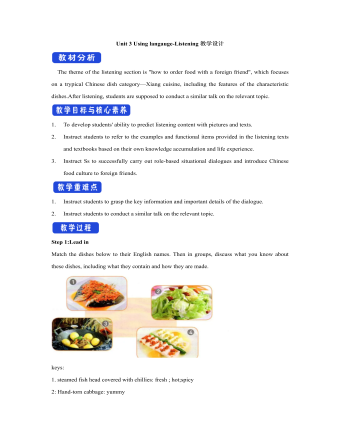
新人教版高中英语选修2Unit 3 Using langauge-Listening教学设计
1. How is Hunan cuisine somewhat different from Sichuan cuisine?The heat in Sichuan cuisine comes from chilies and Sichuan peppercorns. Human cuisine is often hotter and the heat comes from just chilies.2.What are the reasons why Hunan people like spicy food?Because they are a bold people. But many Chinese people think that hot food helps them overcome the effects of rainy or wet weather.3.Why do so many people love steamed fish head covered with chilies?People love it because the meat is quite tender and there are very few small bones.4.Why does Tingting recommend bridge tofu instead of dry pot duck with golden buns?Because bridge tofu has a lighter taste.5 .Why is red braised pork the most famous dish?Because Chairman Mao was from Hunan, and this was his favorite food.Step 5: Instruct students to make a short presentation to the class about your choice. Use the example and useful phrases below to help them.? In groups of three, discuss what types of restaurant you would like to take a foreign visitor to, and why. Then take turns role-playing taking your foreign guest to the restaurant you have chosen. One of you should act as the foreign guest, one as the Chinese host, and one as the waiter or waitress. You may start like this:? EXAMPLE? A: I really love spicy food, so what dish would you recommend?? B: I suggest Mapo tofu.? A: Really ? what's that?
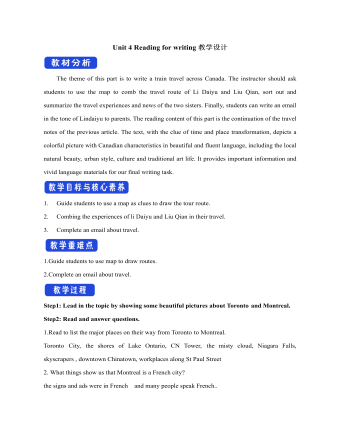
新人教版高中英语选修2Unit 4 Reading for writing教学设计
假定你是英国的Jack,打算来中国旅行,请你给你的中国笔友李华写一封信,要点如下:1.你的旅行计划:北京→泰山→杭州;2.征求建议并询问他是否愿意充当你的导游。注意:1.词数80左右(开头和结尾已给出,不计入总词数);2.可以适当增加细节,以使行文连贯。参考词汇:故宫 the Forbidden City;泰山 Mount TaiDear Li Hua,I'm glad to tell you that 'm going to visit China.First,I am planning to visit Beijing,the capitalof China,where I am looking forward to enjoying the Great Wall,the Forbidden City and somebeautiful parks.Then I intend to go to visit Mount Tai in Shandong Province.I've heard that it is one ofthe most famous mountains in China and I can't wait to enjoy the amazing sunrise there.After that,I amalso going to Hangzhou.It is said that it is a beautiful modern city with breathtaking natural sights,among which the West Lake is a well- known tourist attraction.What do you think of my travel plan? Will you act as my guide? Hope to hear from you soon.
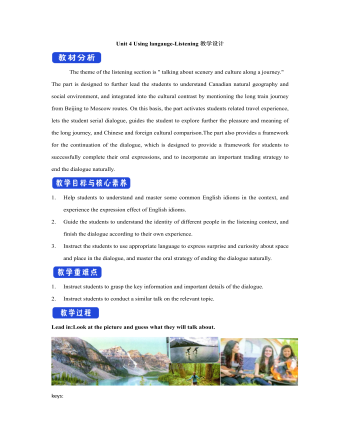
新人教版高中英语选修2Unit 4 Using langauge-Listening教学设计
The theme of the listening section is " talking about scenery and culture along a journey."The part is designed to further lead the students to understand Canadian natural geography and social environment, and integrated into the cultural contrast by mentioning the long train journey from Beijing to Moscow routes. On this basis, the part activates students related travel experience, lets the student serial dialogue, guides the student to explore further the pleasure and meaning of the long journey, and Chinese and foreign cultural comparison.The part also provides a framework for the continuation of the dialogue, which is designed to provide a framework for students to successfully complete their oral expressions, and to incorporate an important trading strategy to end the dialogue naturally.1. Help students to understand and master some common English idioms in the context, and experience the expression effect of English idioms.2. Guide the students to understand the identity of different people in the listening context, and finish the dialogue according to their own experience.3. Instruct the students to use appropriate language to express surprise and curiosity about space and place in the dialogue, and master the oral strategy of ending the dialogue naturally.1. Instruct students to grasp the key information and important details of the dialogue.2. Instruct students to conduct a similar talk on the relevant topic.
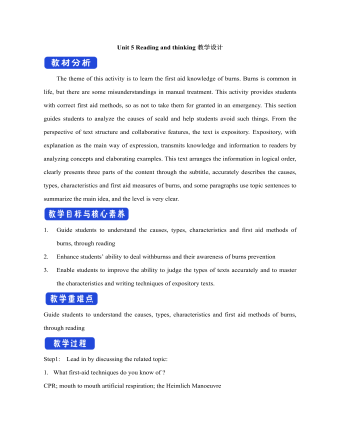
新人教版高中英语选修2Unit 5 Reading and thinking教学设计
The theme of this activity is to learn the first aid knowledge of burns. Burns is common in life, but there are some misunderstandings in manual treatment. This activity provides students with correct first aid methods, so as not to take them for granted in an emergency. This section guides students to analyze the causes of scald and help students avoid such things. From the perspective of text structure and collaborative features, the text is expository. Expository, with explanation as the main way of expression, transmits knowledge and information to readers by analyzing concepts and elaborating examples. This text arranges the information in logical order, clearly presents three parts of the content through the subtitle, accurately describes the causes, types, characteristics and first aid measures of burns, and some paragraphs use topic sentences to summarize the main idea, and the level is very clear.1. Guide students to understand the causes, types, characteristics and first aid methods of burns, through reading2. Enhance students’ ability to deal withburnss and their awareness of burns prevention3. Enable students to improve the ability to judge the types of texts accurately and to master the characteristics and writing techniques of expository texts.Guide students to understand the causes, types, characteristics and first aid methods of burns, through readingStep1: Lead in by discussing the related topic:1. What first-aid techniques do you know of ?CPR; mouth to mouth artificial respiration; the Heimlich Manoeuvre
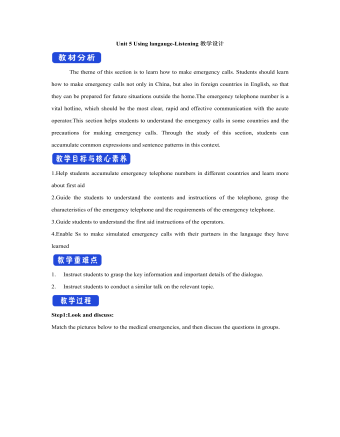
新人教版高中英语选修2Unit 5 Using langauge-Listening教学设计
The theme of this section is to learn how to make emergency calls. Students should learn how to make emergency calls not only in China, but also in foreign countries in English, so that they can be prepared for future situations outside the home.The emergency telephone number is a vital hotline, which should be the most clear, rapid and effective communication with the acute operator.This section helps students to understand the emergency calls in some countries and the precautions for making emergency calls. Through the study of this section, students can accumulate common expressions and sentence patterns in this context. 1.Help students accumulate emergency telephone numbers in different countries and learn more about first aid2.Guide the students to understand the contents and instructions of the telephone, grasp the characteristics of the emergency telephone and the requirements of the emergency telephone.3.Guide students to understand the first aid instructions of the operators.4.Enable Ss to make simulated emergency calls with their partners in the language they have learned1. Instruct students to grasp the key information and important details of the dialogue.2. Instruct students to conduct a similar talk on the relevant topic.Step1:Look and discuss:Match the pictures below to the medical emergencies, and then discuss the questions in groups.
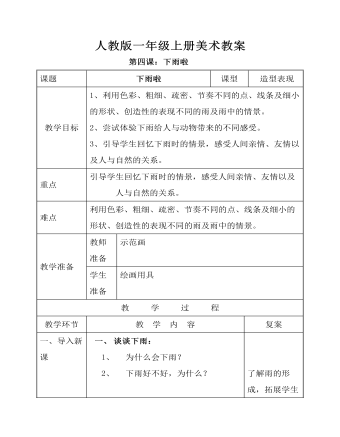
小学美术人教版一年级上册《第4课下雨啦》教案说课稿
1、利用色彩、粗细、疏密、节奏不同的点、线条及细小的形状、创造性的表现不同的雨及雨中的情景。2、尝试体验下雨给人与动物带来的不同感受。3、引导学生回忆下雨时的情景,感受人间亲情、友情以及人与自然的关系。
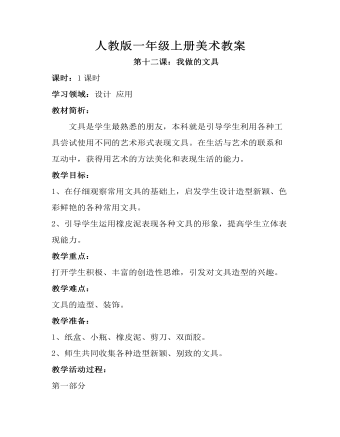
小学美术人教版一年级上册《第12课我做的“文具”》教案说课稿
教学目标:1、在仔细观察常用文具的基础上,启发学生设计造型新颖、色彩鲜艳的各种常用文具。2、引导学生运用橡皮泥表现各种文具的形象,提高学生立体表现能力。教学重点:打开学生积极、丰富的创造性思维,引发对文具造型的兴趣。

小学美术人教版二年级上册《第9课蜻蜓飞飞》教案说课稿
1、引导学生观察蜻蜓,抓住蜻蜓的特点进行绘画创作。2、充分发挥学生的想象和创造能力。课前准备:教具:课件、模具、图片、有关作品。学具:作业纸、画笔。教学过程一、导入课题1.教师出示一张纸,变成折纸蜻蜓激起学生兴趣。2.出示课题:蜻蜓飞飞二、新授课1、交流课前收集的资料。请学生谈谈收集的关于蜻蜓的知识,教师补充介绍。2、学生仔细观察蜻蜓模具,结合课件图片小组内交流讨论:蜻蜓是由哪些部分组成的,各有怎样的特点?
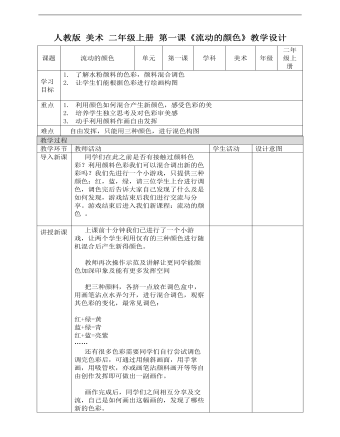
小学美术人教版二年级上册《第1课流动的颜色》教案说课稿
同学们在此之前是否有接触过颜料色彩?利用颜料色彩我们可以混合调出新的色彩吗?我们先进行一个小游戏,只提供三种颜色:红,蓝,绿,请三位学生上台进行调色,调色完后告诉大家自己发现了什么及是如何发现,游戏结束后我们进行交流与分享。游戏结束后进入我们新课程:流动的颜色 。
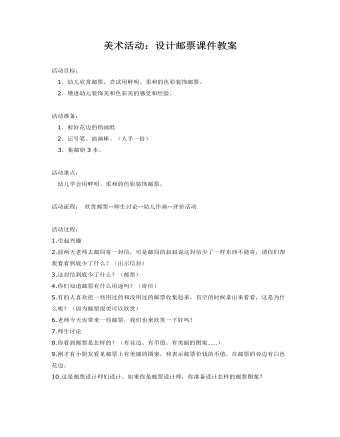
美术活动:设计邮票课件教案
2.增进幼儿装饰美和色彩美的感受和经验。 活动准备:1.剪好花边的铅画纸2.记号笔、油画棒。(人手一份) 3.集邮册3本。活动重点: 幼儿学会用鲜明、柔和的色彩装饰邮票。活动流程:欣赏邮票--师生讨论--幼儿作画--评价活动
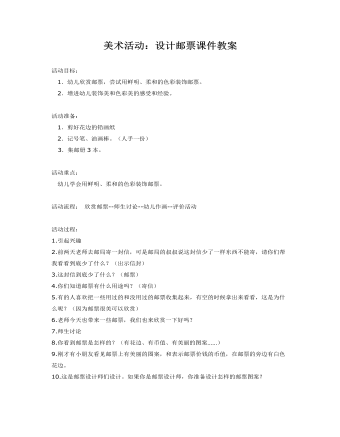
美术活动:设计邮票课件教案
2.增进幼儿装饰美和色彩美的感受和经验。 活动准备:1.剪好花边的铅画纸2.记号笔、油画棒。(人手一份) 3.集邮册3本。活动重点: 幼儿学会用鲜明、柔和的色彩装饰邮票。活动流程:欣赏邮票--师生讨论--幼儿作画--评价活动
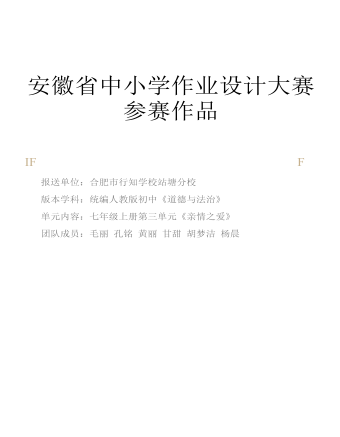
初中道德与法治七年级上册亲情之爱作业设计
2. 内容内在逻辑本单元亲子之间的交往既承接了上一课的“师生之间”的交往,也为七年级 下册关于中学生提升在集体中的交往水平和能力奠定了坚实的基础,因此本单元 在教材中起承上启下的作用。第一框“家的意味”,通过对“家规” “家训”的探究,引出中国家庭文化中“孝”的精神内涵,引导学生对家庭美德进行深入思考,学会孝亲敬长。第二框“爱在家人间”,通过体验家人间的亲情之爱,进而引导学生感受对 家人割舍不断的情感。第三框“让家更美好”,通过对传统家庭与现代家庭的比较,引导学生认识 现代家庭的特点,树立共创共享家庭美德的意识,共创和谐美德之家。从初识家中“孝”,体验家中“爱”,处理家中“冲突”,到自觉共建家庭 “美德”,学生逐步体味亲情之爱,将“亲情之爱”内化于心、夕卜化于行。(三)学情分析(1) 认知水平与心理特点七年级学生正处于青春期,是生理和心理急剧变化的关键时期,自我意识不 断增强,逆反心理更加强烈,情绪波动较大。
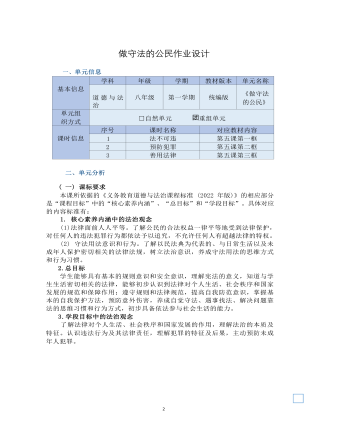
道德与法治八年级上册做守法的公民作业设计
一、单项选择题1.违法行为是指出于过错违法法律、法规的规定,危害社会的行为。下列违法行 为属于行政违法行为的有 ( )①欠债不还 ②谎报险情 ③殴打他人 ④故意杀人A.①② B.②③ C.①③ D.③④2.一般违法行为和犯罪的共同点是 ( )A.都违反了民事法律 B.都要受到刑罚处罚C.承担相同法律责任 D.都具有社会危害性3.“人生不能越界,底线必须坚守”。这句话说明人们行为的底线是 ( )A.守诚信 B.讲道德 C.不违法 D.懂礼仪4.犯罪的最本质特征是 ( )A.严重社会危害性 B.刑事违法性C.应受刑罚处罚性 D.触犯法律性 5.初中生小辉因沉迷网络游戏,经常偷父母的钱。后来发展为盗窃,走上了违法犯罪的道路。这告诉我们 ( )①不良行为必然会发展成违法犯罪行为②网络游戏有害健康,我们应远离网络③预防违法犯罪需要强化防微杜渐意识④要理性参与网络生活,做网络的主人A.①② B.②③ C.①③ D.③④
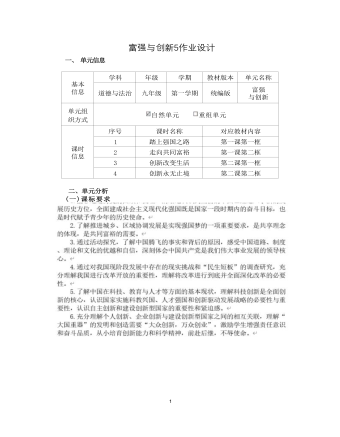
九年级上册道德与法治富强与创新5作业设计
(2) 厦门经济特区成立40年来,在各项事业上都实现历史性跨越和突破, 为国家建设做出重要贡献。 厦门的发展表明当代中国最鲜明的特色是( )A.创新发展 B.经济建设 C.可持续发展 D.改革开放(3) 下列选择中,有利于解决我国当前社会主要矛盾的是( )①以经济建设为中心,解放发展生产力②坚持全面深化改革,实施创新驱动发展③推进城乡一体化发展,实现区域同步发展④兜住民生底线、补齐民生短板、办好民生实事A.①②③ B.①②④ C.①③④ D.②③④(4) 2021是 “十四五” 的开局之年。这一年,我国的战略科技力量发展加 快,改革开放推向纵深,民生得到有力和有效的保障,生态文明建设持续推进,┉┉ 。下列时事与此描述相符合的有 ( )①举行第四届中国国际进口博览会②退休人员的基本养老金实现17连涨③正式提出2030碳达峰和2060碳中和战略目标④成功举办24届北京冬奥会和13届北京冬残奥会A.①②③ B.①②④ C.①③④ D.②③④A.治国有常,而利民为本 B.民相亲在于心相通C.君远相知,不道云海深 D.人而无信,不知其可也
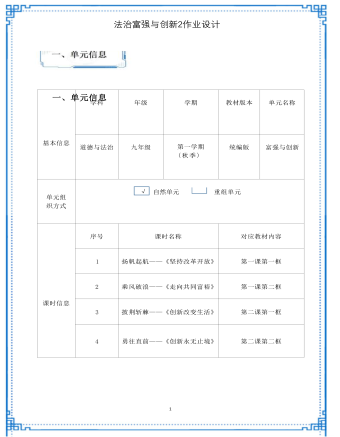
九年级上册道德与法治富强与创新2作业设计
【作业分析】本题考查创新改变生活。防雨神器自动收晾衣服的灵感来源是下 雨忘记收衣服被批评,体现创新是来源于生活、来源于实践。“智能晴雨棚”打 破了传统的只能晾衣服的常规。而由教材内容可知,创新是改革开放的生命, 改革在不断创新中提升发展品质,所以②错误;故本题选 C2. (改编) 利用“安康码”自动定位,即可监测附近新冠肺炎感染病例发病点; 通过输入自己的手机号码,即可通过“通信大数据卡”判断自己是否到访过高 危地区;通过皖事通 APP“密接人员自查”即可查询自己是否曾与新冠肺炎感染 患者接触……疫情发生以来,大数据、健康码、无人机、机器人、测温仪等众 多科技创新成果纷纷登场,助力疫情防控,提高了抗击疫情的精准化水平。这 表明 ( )①标志着我国已经成为科技强国②实施创新驱动发展战略成效显著③创新应成为国家发展进步的中心工作④创新的目的是增进人类福祉,让生活更美好A.①② B.②③ C.①④ D.②④【评价实施主体】教师【评价标准】D【作业分析】本题考查科技创新改变生活中创新的重要性。我国现在还不是科 技强国,但科技自主创新能力不断增强,所以①说法错误。
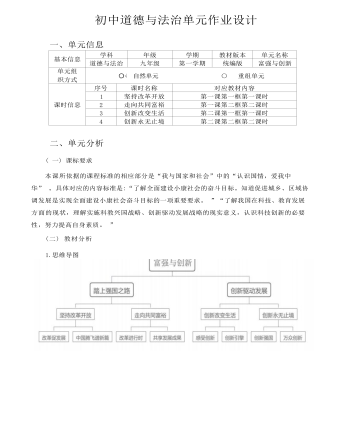
九年级上册道德与法治富强与创新3作业设计
总体评价结果: 。(四)作业分析与设计意图这是一项基于素质教育导向,以培育学生课程核心素养为目标的整课时作业设计。第一题作业以连线题的方式呈现。学生通过连线题掌握必备基础知识,完成教材知识的 整理和分析。第二题作业以演讲提纲的方式呈现。通过该题业设计与实施,引导学生了解中国科技创 新的现状,感受自主创新的重要性,探究如何为建设创新型国家而努力。引导同学们知道国 家的创新青少年责无旁贷,增强为国家创新做贡献的责任感和使命感,增强民族自尊心和自 豪感,增强政治认同。六、单元质量检测( 一) 单元质量检测内容1.单项选择题(1)要弘扬改革创新精神,推动思想再解放、改革再深入、工作再抓实,凝聚起全面深化 改革的强大力量,在新起点上实现新突破。下列关于改革开放的认识正确的有 ( )①改革开放是强国之路②改革开放推动了全世界的发展③改革开放解决了当前中国的一切问题
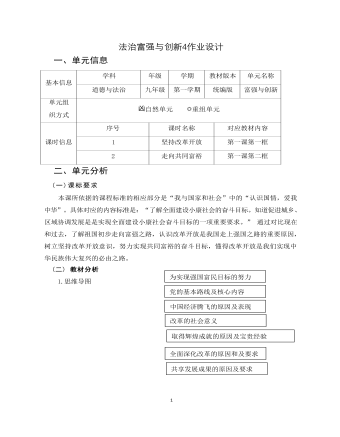
九年级上册道德与法治富强与创新4作业设计
4.2021 年是我国航天事业创建 65 周年,也是收获满满的一年,从“两弹一星”到“神舟” 载人,从“北斗”指路到“嫦娥”奔月、“天问”探火,从无人飞行到载人飞行,从舱内 实验到太空行走,从太空短期停留到中长期驻留……这说明 ( )①我国科技发展水平总体较高②我国综合国力和自主创新能力不断增强③我国实行科教兴国战略取得了显著成效④我国科技在某些尖端领域居于世界领先地位A.①②③ B.①②④ C.①③④ D.②③④5.中国工程院院士张伯礼在讲述他赴武汉抗疫故事时这样感慨:“科学研究是一个养兵千日、 用兵一时的创新事业。”围绕疫苗研发,各攻关团队日夜奋战,在尊重科学、保障安全的 前提下,最大限度缩短研发时间,为本国和全球应对新冠肺炎疫情提供有力支撑。我们在防疫科研人员身上看到 ( )①造福人类的济世情怀 ②律己宽人的处事原则③沟通合作的团队精神 ④见利思义的高尚情操A.①② B.①③ C.②④ D.③④





















